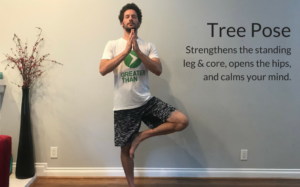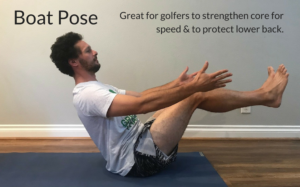Yoga is an ancient art of tranquility, flexibility and the ability to stay present in your current state and block out the distractions of life. This sounds like another activity played with 18 holes and a club. Regular practice of yoga can lend some key benefits
to your golf game. Mastering the fundamentals of proper breathing, the primary or key positions, and the ability to maintain balance and presence are all absolutely critical components needed for success on the course. Elite golfers today must be powerful, balanced and fluid in their physical motion, and both confident and focused mentally, all of which can be positively influenced through yoga. In this article, we’ll break down 5 ways that a yoga practice can improve your golf game.
“Elite golfers must be powerful, balanced and fluid in their physical motion, confident and focused, all of which can be positively influenced through yoga.”
1. Ability to Concentrate and Downregulate
Yoga is as much a mental challenge as it is physical. Many positions in yoga are physically difficult, while others, such as standing on one leg for an extended period of time, are mentally challenging to stay focused, present and aware. Similarly, to perform at your highest level in golf, it requires the ability to combine both intense concentration with relaxed confidence. While this may seem like an abstract concept, it is a practicable mental skill, that can be honed through meditation practices which are often part of a yoga practice.
When anxiety or nerves, A.K.A. our fight or flight response, kicks in, practiced meditations and breathing practices can help us calm the anxiety and come back to a place of both confidence and focus.
Try this: Easy Seated Pose.
- Sit up tall to take slower & smoother breaths. With mindful breathing, you’ll be able to keep a calm, clear & positive mind & body.
- Relax your shoulders, relax your jaw, relax your entire body but keep growing your spine tall (posture posture posture).
- Slightly tuck your tailbone & engage your core.
- Option to sit on a block/ blanket for tight hips.

2. Ability to Explosively Rotate
Arguably the most common injury related to golf is back strains or injuries. For even the healthiest of athletes, golf is an explosive rotational sport that requires a good deal of mobility to continue to rotate over the course of several days if participating in tournament play, for example. A golf swing requires incredible mobility in the hips, lower back and thoracic spine to allow for sufficient range of motion and speed. Poses such as the pigeon pose in yoga, or another motion commonly called the world’s greatest stretch, are excellent exercises for increasing flexibility and mobility in the hips, lower back and thoracic spine; critical areas for performance and big drives on the course.
“Poses such as the pigeon increase flexibility and mobility in the hips, lower back and thoracic spine; critical areas for big drives on the course.”
Try this: Half Pigeon Pose.
- Keep your back leg straight, bring your front shin as parallel to the top of your mat,
- Flex your front foot, and square your hips.
- Option to place a block/blanket under your hips. Option to fold down.
3. Single Leg Stability
In the motion of a typical golf swing, golfers will shift their weight from their back leg in the back swing, to the lead leg in the down swing and follow through. One of the key elements of a good swing is the golfer must be stable enough to control the back swing, and time the push off of their lead leg with contact and follow through on the ball.
A golfer who possesses poor balance or stability on one or both legs will not have an ideal swing as they will have physical limitations, they may lose timing on the back swing as their back leg does not accept the load of force well, or they may not be able to time and follow through effectively without being able to transfer power and push off the lead leg.
Yoga is a practice with a multitude of single leg and balance exercises. Developing strength and balance in each leg unilaterally, especially using bare feet and from the ground up, is a critical benefit yoga can deliver to golfers.
Try this: Tree Pose.
- Bring your lifted foot to the inside of your standing leg, peel your knee open, tuck your tailbone, engage your core, lengthen your spine & relax your shoulders.
- Option to bring lifted foot to inner ankle, shin or thigh.

4. Core Strength
As mentioned previously, the golf swing requires the golfer to disassociate their hips and shoulders in order to rotate effectively and follow through. While this motion may be possible with enough flexibility, it will not contribute to improved results on the course without a strong core to transfer the force. The core is the connective force between the hips and thoracic spine. A great swing times the co-contraction of these two areas as they re-associate from the back swing into contact with the ball, requiring a great deal of core strength to bring it all together into a powerful motion. In addition, a strong core is generally the best solution to a troublesome lower back. The core muscles are inherently designed to protect the lumbar spine from harm, by stabilizing the lumbar spine and keeping it from over-rotating.
Try this: Boat Pose.
- Keep your spine long, chest lifted, core engaged.
- Hug your inner thighs together to keep legs engaged, Flex all 10 toes.
- Option to bring feet to floor or gently place your hands behind thigh for extra support,

5. Cool Down And Injury Prevention
At the end of a long day on the course, very often the muscles are tight, backs are sore and we want nothing more than to sit down and enjoy a drink. However, the smart golfer will cool down after a grueling session on the course to help their body recover properly and prevent potential injury concerns that can arise. A 10 to 15-minute yoga routine of basic poses, breathing and stretching can work wonders over time as it helps the body cool down and down-regulate from the focus of playing, it stretches and gets blood flow to sore or overworked muscle groups, and is a perfect time for golfers to meditate and mentally digest their performance and move on with the rest of the day.
“A 10 to 15-minute yoga routine of basic poses, breathing and stretching can work wonders over time as it helps the body cool down and down-regulate from the focus of playing.”
Try this: Standing Forward Fold
- Stand feet hip with distance apart.
- Hinge from hips, lengthen spine and fold your torso down. Try to connect chest to thighs.
- Relax head. Grab opposite elbows.
- Option to bend your knees as much as you need.

Yoga, much like golf, is a practice that requires mobility, concentration, focus, and balance. A yoga practice could be the difference between dominating the course and perennial frustration.


